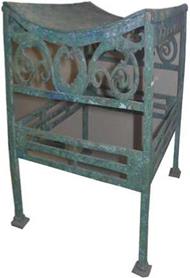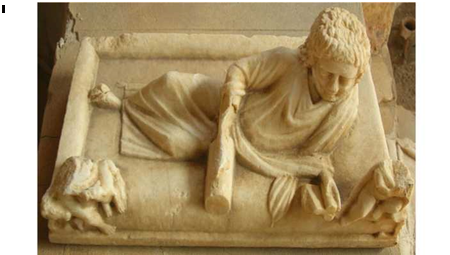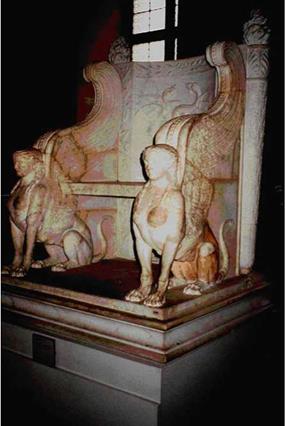In Roman, furniture practicals ruled, which consisted in adapting all useful aesthetic, structural and organisational solutions of the peoples of the conquered countries. The civilisation predecessors of Rome were the Etruscans, who through their contacts with the Greeks, brought many interesting solutions into their territory. This is why in appearance, the Etruscan and Roman beds resemble Greek furniture (Fig. 1.17).
In Rome, furniture designed for sitting was known under the generic name sella; only a chair with armrests was called a kathedra (Setkowicz 1969). Furniture that emphasised power also included the stool kurulne (sella curtulis). This is a structure in the form of a stool, without a backrest, with legs bent and crossed, with a pillow placed on the seat. Initially, chairs and stools were made of wood, as well as metal incrusted with ivory, in later times they were also decorated with gold (Fig. 1.18).
Kathedra-type chairs, similar to the chair of the Greek klismos, had the legs bent outwards, but they were characterised by much greater sizes of cross sections of individual elements. The Solium was a representative chair, the seat of honour of the man of the house, as well as the throne of the head of the State and other dignitaries of the administration. At one of such piece of furniture, the seat is supported by two Sphinxes, which wings that are raised up high form armrests (Fig. 1.19).
The Romans used three types of beds: for resting—lectus cubicularis, for feasting—lectus tricliniaris, for work—lectus lucubratorius (Setkowicz 1969). The bed construction was mostly a frame supported on four legs. The supporting and

 |
Fig. 1.18 Metal stool like sella, around 100 B. C. (British Museum)
springy layer was made from brown tapes woven over one another, which formed a kind of chess board. Roman sleeping beds were usually built as lightweight and portable, in whole or in part from metal, with an S-shaped headboard, usually on both sides of the bed. Some beds of wealthy Romans were lined with mattresses
 |
filled with wool and goose or swan feathers. The Romans were the first also to make furniture woven from cane. Among the different types of wood, Roman artisans mainly used walnut, ash, beech, ebony, and as auxiliary types palm, lemon and thuja.
Roman dining tables were similar to Greek ones. Lightweight, movable, three-legged or one-legged, low tables, reaching only the height of the bed, exhibited elegance. Three-legged and four-legged tables had a structure made of cross-linked bars making it possible to fold the frame after removing the work top. In contrast to this design, in homes surrounding the ancient Agora, stone tables were erected with a wide work top and massive stem in the form of a stone column. The tops of these tables in the form of an elongated rectangle were either marble or wooden.
The Romans also knew the principle of building wooden cabinets, called armaria, filled with shelves for storage. In the atrium of the Roman house stood a chest, which stored the household valuables. The chest was made of wood and fitted ornamentally with iron and bronze tapes, which protected it against an intruder.



